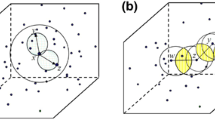Abstract
Geographic routing protocols forward packets according to the geographical locations of nodes. Thus, the criteria used to select a forwarding node impacts on the performance of the protocols such as energy efficiency and end-to-end transmission delay. In this paper, we propose a congestion aware forwarder selection (CAFS) method for a geographic routing protocol. To design CAFS, we devise a cost function by combining not only the forward progress made to a packet but also the amount of energy required for packet forwarding, forwarding direction, and congestion levels of potential forwarders. Among the potential forwarders, CAFS selects the next forwarder having the minimum cost. In our simulation studies, we compare the performance of CAFS with those of the maximum progress (MP) method and the cost over progress (CoP) method in various network conditions. The results show that compared with MP, the length of a routing path in terms of the number of hops becomes longer when CAFS is used. However, the shorter hop distance helps to avoid unnecessary retransmissions caused by packet loss in a wireless channel. In addition, since CAFS considers congestion levels of candidate forwarders, it reduces the queuing delay in each forwarder. Therefore, CAFS is superior to the MP and the CoP in terms of the energy consumption, end-to-end packet transfer delay, and the successful packet delivery rate.








Similar content being viewed by others
References
Zhang, H., & Shen, H. (2010). Energy-efficient beaconless geographic routing in wireless sensor networks. IEEE Transactions on Parallel and Distributed Systems, 21(6), 881–896.
Subramanian, S., & Shakkottai, S. (2010). Geographic routing with limited information in sensor networks. IEEE Transactions on Information Theory, 56(9), 4506–4519.
Huang, H., Hu, G., Yu, F., & Zhang, Z. (2011). Energy-aware interference-sensitive geographic routing in wireless sensor networks. IET Communications, 5(18), 2692–2702.
Xu, Y., Lee, W.-C., Xu, J., & Mitchell, G. (2005) PSGR: Priority-based stateless geo-routing in wireless sensor networks. In Proceedings of the IEEE international conference on mobile adhoc and sensor systems (pp. 673–680).
Leibnitz, K., Wakamiya, N., & Murata, M. (2006). Self-adaptive ad-hoc/sensor network routing with attractor selection. In Proceedings of the IEEE international conference on global telecommunications (pp. 1–5).
Chawla, M., Goel, N., Kalaichelvan, K., Nayak, A., & Stojmenovic, I. (2006). Beaconless position based routing with guaranteed delivery for wireless ad-hoc and sensor networks. In Proceedings of the IFIP international interactive conference on ad-hoc networking (pp. 61–70).
Amadou, I., & Valois, F. (2010). Pizza forwarding: A beaconless routing protocol designed for realistic radio assumptions. In Proceedings of the IEEE international conference on sensor technologies and applications (pp. 495–500).
Park, J. (2013). A geometric approach to model a detour success probability for geographic routing protocols. In Proceedings of the international workshop on smart technologies for energy, information, and communication.
Chen, D., & Varshney, P. K. (2007). A survey of void handling techniques for geographic routing in wireless networks. IEEE Communications Surveys and Tutorials, 9(1), 50–67.
Gao, D., Zheng, T., Zhang, S., & Yang, O. W. W. (2010). Improved gradient-based micro sensor routing protocol with node sleep scheduling in wireless sensor networks. In Proceedings of the IEEE international conference on vehicular technology (pp. 1–5).
Omprakash, G., Rodrigo, F., Kyle, J., Moss, D., & Philip, L. (2009) Collection tree protocol. In Proceedings of the ACM international conference on embeded networked sensor system (pp. 1–14).
Heissenbuttel, M., Braun, T., Bernoulli, T., & Walchli, M. (2004). BLR: Beacon-less routing algorithm for mobile ad-hoc networks. Elsevier Computer Communications, 27(11), 1076–1086.
Witt, M., & Turau, V. (2005). BGR: Blind geographic routing for sensor networks. In Proceedings of the IEEE international workshop on intelligent solution in embedded systems (pp. 51–61).
Watteyne, T., Molinaro, A., Richichi, M. G., & Dohler, M. (2011). From MANET To IETF ROLL standardization: A paradigm shift in WSN routing protocols. IEEE Communications Surveys and Tutorials, 13(4), 688–707.
Takagi, H., & Kleinrock, L. (1984). Optimal transmission ranges for randomly distributed packet radio terminals. IEEE Transactions on Communications, 22(3), 246–257.
Stojmenovic, I., & Lin, X. (2001). Power-aware localized routing in wireless sensor networks. IEEE Transactions on Parallel and Distributed Systems, 12(11), 1122–1133.
Stojmenovic, I. (2003). Position based routing in ad hoc networks. IEEE Communications Magazine, 40(7), 128–134.
Elhafsi, E. H., Mitton, N., & Simplot-Ryl, D. (2007). Cost over progress based energy efficient routing over virtual coordinates in wireless sensor network. In Proceedings of the IEEE international symposium on world of wireless, mobile and multimedia networks (pp. 1–6).
Huang, C., Fei, D., & Jie, W. (2004). On-demand location-aided qos routing in ad hoc networks. In Proceedings of the IEEE international conference on parallel processing (pp. 502–509).
Kuruvila, J., Nayak, A., & Stojmenovic, I. (2006). Progress and location based localized power aware routing for ad hoc and sensor wireless networks. Hindawi International Journal of Distributed Sensor Networks, 2(2), 147–159.
Kleinrock, L. (1975). Queuing systems volume 1: Theory (pp. 94–99). Canada: Wiley.
Rappaport, T. S. (2002). Wireless communications, principles and practice (pp. 138–144). NJ: Prentice Hall.
Author information
Authors and Affiliations
Corresponding author
Additional information
This work was partly supported by the GRRC program of Gyeonggi province [(GRRC SUWON2014-B2), Study on Object Recognition System for Industrial Security and Intelligent Control System for Establishing Social Safety Net Based on Advanced Neuro-Fuzzy Technologies], and by Basic Science Research Program through the National Research Foundation of Korea funded by the Ministry of Education, Science and Technology (NRF-2011-0007076 (2014-0046)).
Rights and permissions
About this article
Cite this article
Park, J. Congestion Aware Geographic Routing Protocol for Wireless Ad Hoc and Sensor Networks. Wireless Pers Commun 78, 1905–1916 (2014). https://doi.org/10.1007/s11277-014-2052-0
Published:
Issue Date:
DOI: https://doi.org/10.1007/s11277-014-2052-0




